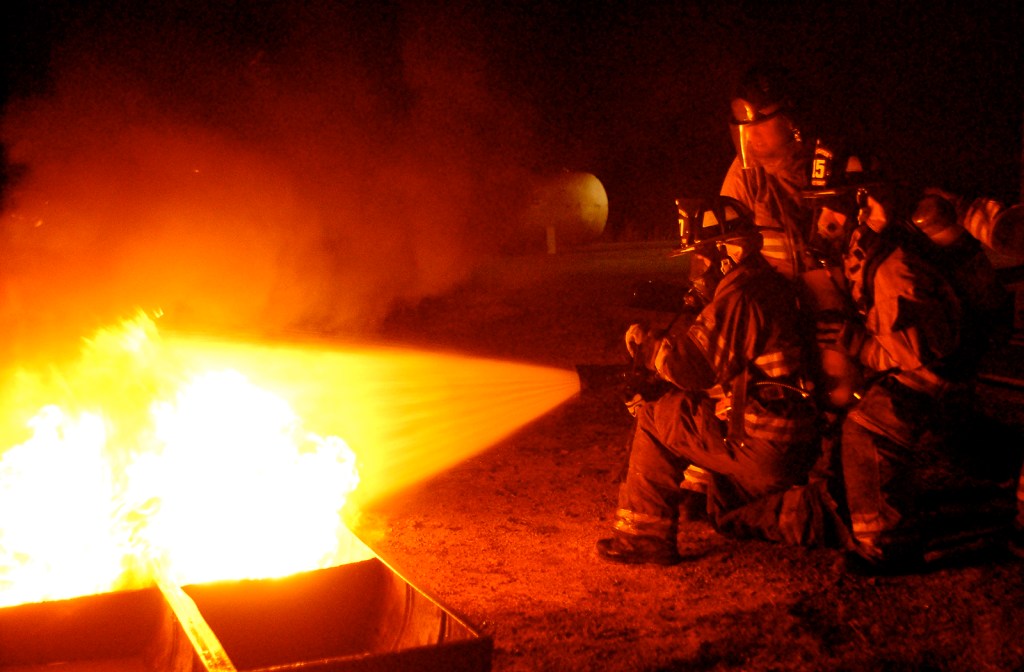Training Day
Published 10:19 pm Thursday, March 9, 2006

- In this Times photo from March 8, 2006, Tony Parker, back left, supervises a training exercise with Tim Owen, right, and Michael Rauch at the Cullman County volunteer fire training facility in Vinemont.
This is the fourth in a six-part series on Volunteer Fire Departments in Cullman County.
There’s more to putting out fires than aiming a hose, as several dozen trainees in a volunteer firefighter certification class are learning.
A class of more than 30 volunteer firefighters seeking state certification are working through a 160-hour course that started in January.
The course, led by Good Hope firefighter Tony Parker, involves both classroom and practical work on fire behavior, communications, equipment, emergency medical response and hazardous materials.
Wednesday night at a training center near the Cullman County Agricultural Trade Center in Vinemont, trainees took a break from textbooks, geared up and had turns extinguishing a diesel fire.
Parker and other veteran firefighters guided trainees as they put out a blazing mix of straw and diesel fuel in a metal basin.
“You want to put the nozzle on fog, get real close to the fire and use that semi-fog to smother it instead of blowing it away,” explained Good Hope Fire Chief David Scott.
Or, as student Waylon Echols of Bethsadia recited Parker’s favorite phrase, “Put the wet stuff on the red stuff.”
Parker said the course will run through May, meeting two nights a week in Good Hope for classroom work and every other Saturday. Each individual department has its own policy on whether certification is required; Good Hope mandates that firefighters become certified by passing a 150-question test within two years of joining the department.
Passing the certification test is also a prerequisite for entrance to the Alabama State Fire College in Tuscaloosa.
“You can tell the difference between a firefighter who’s certified and one who isn’t, if they have the same experience,” Parker said.
The training facility, in a wooded area down a long gravel driveway off U.S. Highway 31, is maintained by the Cullman County Volunteer Fire Departments Association. Euell Hodge, president of the association and a volunteer firefighter for more than three decades, said the county government provides some funding for upkeep.
The centerpiece of the facility is a three-story metal burn building that reeks of past use. Training fires set in the building’s rooms, with blackened furniture to simulate a home environment, can reach 400 degrees, Hodge said.
The building has two grimy residents — Hose Buddy, a child-sized doll roughly shaped like a stick figure, scorched and patched with duct tape, and Elvis, its heftier relative.
Hose Buddy is hidden among the punished recliners and sofas for trainees to find, while Elvis tests a firefighter’s carrying strength.
“It’s a mental thing to find Hose Buddy, and it’s a physical thing to carry Elvis,” Echols said.
On the top floor is “The Maze,” a claustrophobic path of crawl space that teaches trainees to remain calm and find their way out of tight spaces without visibility — important skills, Hodge said.
“You can put a 25-minute air pack on, but if you get to hyperventilating in there, it won’t last long,” he said.
Most trainees seem to enjoy the practical work.
“A lot of them get a little competition going among themselves, they cheer each other on,” Scott said. “It’s stuff you’re gonna use and see on the scene. You never know what you’re gonna see.”
The physical and mental stress cause about half who start the course to drop out, Parker said, but a lot of it depends on a student’s motivation.
“All you need to have is a desire to help somebody, do the training and abide by the rules and regulations of each individual fire department,” he said.


